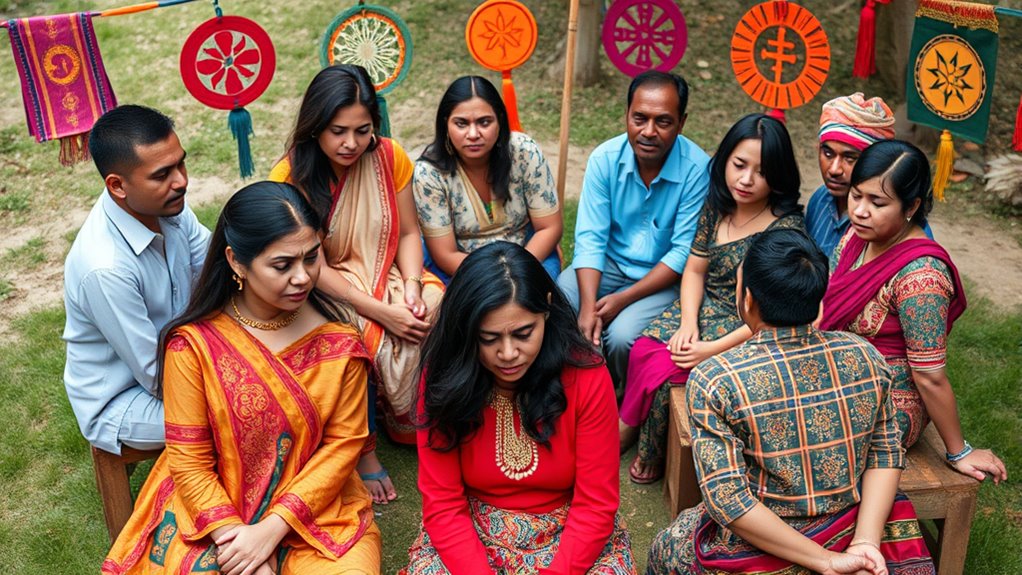Yes, culture profoundly influences how BPD shows up, how it’s diagnosed, and how everyone responds to it. Norms around emotions, relationships, and self-harm differ across societies, affecting symptom expression and interpretation. In some cultures, fears of abandonment may look different, and self-harm methods vary widely. Understanding these differences helps in providing proper care. To learn more about how culture shapes BPD, keep exploring these key factors.
Key Takeaways
- Cultural norms shape how BPD symptoms are expressed and perceived, affecting diagnosis and treatment approaches.
- Variations exist in self-harm methods and triggers across cultures, influenced by local social and emotional norms.
- Collectivist and individualist societies differ in relationship fears and interpersonal behaviors associated with BPD.
- Social support networks and community cohesion serve as protective factors, influencing BPD severity across cultures.
- Immigration and cultural transitions can alter symptom expression and impact vulnerability to BPD.
Cultural Variations in BPD Symptom Expression

Cultural context considerably influences how BPD symptoms manifest across different societies. You’ll notice that behaviors considered typical in one culture might signal a disorder in another. For example, in Western societies, fear of abandonment and relationship instability are central BPD features, often linked to individualism. Conversely, in collectivist cultures, these fears may be less prominent or expressed differently, emphasizing group harmony over personal relationships. Self-harm methods also vary; Western individuals may engage in skin mutilation, while in some Eastern regions, poisoning is more common. Additionally, cultural beliefs shape how emotional expression is viewed—some cultures encourage open expression, others promote restraint. Recognizing these variations helps clinicians distinguish between culturally normative behaviors and genuine symptoms, ensuring accurate diagnosis and effective treatment.
The Role of Social Norms and Cultural Contexts in Diagnosis

Social norms shape how behaviors associated with BPD are perceived and interpreted within different cultures. In some societies, emotional expression and interpersonal struggles are seen as normal, making certain BPD symptoms less obvious or pathologized. Conversely, cultures with strict social expectations may label behaviors like emotional volatility or relationship instability as abnormal, influencing diagnosis. Cultural beliefs also affect how clinicians interpret symptoms, such as self-harm or fear of abandonment. Diagnostic criteria developed in Western contexts might not fully capture culturally specific expressions of distress. Consequently, understanding local social norms helps avoid misdiagnosis and guarantees culturally sensitive assessments. Recognizing these norms allows clinicians to differentiate between culturally accepted behaviors and genuine psychopathology, ultimately improving diagnosis accuracy across diverse cultural settings.
Differences in Self-Harm Methods and Underlying Stressors

You’ll notice that self-harm methods and stressors vary widely across cultures, influenced by local norms and access to means. In some regions, poisoning is common, while others see more skin-mutilation, reflecting different cultural practices and resources. Recognizing these differences helps you better understand the underlying stressors that trigger self-harm in diverse populations.
Cultural Self-Harm Variations
How do self-harm methods and their underlying stressors vary across different cultures? You’ll notice that in Eastern countries, self-poisoning is more common among individuals with BPD, often linked to interpersonal conflicts or feelings of shame. In contrast, Western regions tend to see skin-mutilation as the primary method, driven by emotional regulation needs or identity struggles. Cultural norms shape why people self-harm—some cultures view poisoning as a way to escape distress quietly, while others see physical mutilation as an expression of internal pain. Stressors also differ: Western individuals often cite relationship issues, whereas in rural or collectivist societies, social obligations or community pressures play a significant role. Recognizing these cultural differences helps tailor assessments and interventions for better care.
Diverse Stress Triggers
Cultural differences not only influence the methods of self-harm but also shape the specific stressors that trigger these behaviors. In some cultures, interpersonal conflicts or shame-related issues are primary stressors, while others focus on social or economic pressures. For example, in Western societies, fear of abandonment often drives self-harm, whereas in collectivist cultures, family disputes or social harmony concerns are more relevant. These stressors directly impact the chosen self-harm method.
| Culture Type | Common Stressors | Typical Self-Harm Method |
|---|---|---|
| Western | Romantic rejection, loneliness | Skin mutilation, cutting |
| Eastern | Family conflicts, social shame | Poisoning, self-poisoning |
| Rural | Economic hardship, isolation | Poisoning, burning |
| Urban | Relationship breakdowns, academic stress | Cutting, superficial injuries |
| Indigenous | Cultural identity issues, community loss | Self-injury, symbolic acts |
Impact of Social Protective Factors and Immigration on BPD Manifestation

You might notice that strong social support networks in some cultures help prevent BPD symptoms from developing or worsening. When people immigrate, those protective factors often weaken, leading to increased expression of borderline traits. Understanding how social structures and cultural environments influence BPD can improve diagnosis and tailor interventions across different societies.
Protective Social Structures
Social protective factors play a crucial role in shaping the manifestation of BPD across different societies by providing social stability and support that can buffer against the development or severity of borderline traits. Strong community ties, family cohesion, and social norms promoting emotional regulation help prevent the escalation of symptoms. In societies with robust social networks, individuals often experience greater social control, which can suppress the expression of extreme borderline behaviors. Conversely, in environments lacking these protections, BPD traits may become more pronounced or diagnosable. Immigration can disrupt existing social structures, leading to increased vulnerability or changes in symptom presentation. Overall, social support systems influence not only the prevalence but also how BPD manifests, emphasizing the importance of social context in understanding and addressing the disorder.
Cultural Environment Effects
Protective social factors markedly influence how BPD manifests across different environments, shaping the severity and expression of symptoms. In societies with strong community ties and social cohesion, individuals often experience fewer borderline traits or less severe symptoms. Conversely, weaker social protections can allow traits to escalate, increasing diagnosis likelihood. Immigration also impacts BPD presentation; cultural shifts may trigger or suppress symptoms depending on the environment.
| Social Environment | BPD Manifestation |
|---|---|
| Strong community | Fewer symptoms, better coping |
| Weak social ties | Increased severity, instability |
| Immigrant context | Changing symptom expression |
| Cultural norms | Influences on emotional expression |
| Support networks | Buffer against symptom escalation |
Immigration and Expression
Immigration plays a significant role in shaping how BPD symptoms manifest, as individuals encounter new cultural environments that can either trigger or suppress borderline traits. When you move to a different country, social protective factors—like strong community ties, family support, and cultural norms—may weaken or strengthen BPD features. In some cases, the new environment exposes you to stressors that activate maladaptive patterns, while in others, it offers stability that reduces symptom severity. Immigrants often experience identity struggles and emotional regulation challenges as they navigate cultural shifts. These factors influence how BPD presents and evolves. Understanding how immigration impacts BPD helps clinicians tailor assessments and interventions, considering the cultural context shaping each individual’s expression of borderline traits.
Cultural Influences on Relationship Dynamics and Abandonment Fears

Cultural norms deeply influence how individuals perceive and respond to relationship dynamics, shaping the way abandonment fears manifest in those with BPD. In individualistic societies, you might experience intense fears of being left alone, leading to clinginess or frantic efforts to maintain connections. Conversely, in collectivistic cultures, your sense of self ties closely to family or community, so fears of abandonment may focus more on losing social harmony or group cohesion rather than personal relationships. These cultural differences affect how you express and cope with abandonment concerns. You may also interpret relationship instability differently—what’s seen as problematic in one culture might be viewed as normal or even valued in another. Understanding these cultural influences helps clarify how abandonment fears shape your relational behaviors within your cultural context.
Challenges in Applying Western Diagnostic Criteria Cross-Culturally

Applying Western diagnostic criteria for BPD across diverse cultures often presents significant challenges because these standards are rooted in specific cultural norms and understandings of personality and behavior. For example, behaviors considered symptomatic in one culture may be viewed as normal elsewhere. This mismatch can lead to misdiagnosis or missed diagnoses. Cultural differences influence how symptoms like emotional regulation, interpersonal conflicts, or identity disturbances are expressed and interpreted. To illustrate, consider the following:
| Culture/Region | Typical BPD Symptom Expression | Diagnostic Challenges |
|---|---|---|
| Western | Fear of abandonment, self-harm, impulsivity | Cultural norms around independence |
| East Asian | Emotional restraint, relational harmony | Differing perceptions of self and relationships |
| Rural Areas | Community-centered identity, stigma of mental illness | Limited mental health awareness |
| Urban Western | Self-identity struggles, impulsivity | Over-pathologizing culturally normative behaviors |
| Indigenous Societies | Collectivist values, spiritual interpretations | Western criteria may overlook cultural context |
Promoting Culturally Sensitive Approaches in BPD Research and Treatment

To effectively address BPD across diverse populations, clinicians and researchers must prioritize culturally sensitive approaches that respect and incorporate individuals’ unique backgrounds. You can do this by understanding how cultural norms influence symptom expression and diagnosis, and adapting assessments accordingly. Incorporate community perspectives to ensure interventions resonate with clients’ cultural values. Recognize that social support, stigma, and traditional beliefs shape treatment engagement and outcomes.
- Use culturally adapted tools and language in assessments
- Engage community leaders to foster trust and understanding
- Respect cultural definitions of self and relationships
- Incorporate traditional healing practices when appropriate
- Promote ongoing cultural humility and reflexivity in practice and research
The Future of Cross-Cultural Understanding of BPD

How will advancements in research and global collaboration shape the future understanding of BPD across cultures? You can expect more culturally nuanced diagnostic tools that recognize diverse symptom expressions, reducing misdiagnosis. As researchers share data across borders, you’ll see a broader understanding of how social norms and cultural contexts influence BPD features. This collaboration will foster inclusive studies that incorporate underrepresented populations, leading to more accurate, culturally sensitive treatment approaches. Technological innovations like telehealth will improve access to culturally appropriate care worldwide. Additionally, increased awareness and destigmatization efforts will empower communities to seek help without shame. Overall, these developments will help you better understand BPD’s cultural variability, ultimately promoting more effective, personalized interventions that respect individual backgrounds.
Frequently Asked Questions
How Do Cultural Differences Affect BPD Treatment Effectiveness?
Cultural differences substantially influence BPD treatment effectiveness by shaping how symptoms are expressed and understood. You need to take into account cultural norms, family dynamics, and social values, which affect engagement and response to therapy. Tailoring interventions to align with these cultural factors helps improve outcomes. Being culturally sensitive and incorporating community or family support can foster trust, reduce stigma, and make treatments more effective across diverse cultural settings.
Are There Culturally Specific BPD Symptoms Not Captured by Western Diagnoses?
Imagine a vibrant tapestry where each thread represents a unique cultural expression. You find that some culturally specific BPD symptoms, like self-poisoning in India or relationship fears tied to local beliefs, aren’t captured by Western diagnoses. These traits may blend into local customs or be misunderstood. Recognizing this helps you better understand how BPD can present differently across cultures, ensuring more accurate assessments and compassionate care tailored to each person’s cultural background.
How Does Stigma Influence BPD Diagnosis and Help-Seeking Across Cultures?
Stigma deeply affects your willingness to seek help and how BPD is diagnosed across cultures. If stigma exists, you might hide your symptoms or avoid treatment altogether, fearing judgment. Cultural attitudes can make others dismiss your struggles or view BPD as a moral failing, reducing the chances of early diagnosis. Overcoming stigma requires awareness, compassionate understanding, and culturally sensitive approaches to encourage you to pursue support without shame.
What Role Do Traditional Healing Practices Play in BPD Management Globally?
Traditional healing practices often serve as a lifeline in managing BPD worldwide, acting like a bridge connecting you to cultural roots and community support. You might find solace in herbal remedies, spiritual rituals, or talking to local healers, which can complement or sometimes substitute Western treatments. These practices foster trust and understanding, helping you navigate emotional struggles within your cultural context, and offering hope where modern mental health services may be scarce.
Can Cultural Humility Improve Clinician Understanding of BPD in Diverse Populations?
Cultural humility can substantially improve your understanding of BPD in diverse populations. By practicing ongoing self-reflection and acknowledging your biases, you become more open to cultural differences in symptom expression and treatment responses. This approach encourages active listening and respect for clients’ cultural backgrounds, fostering trust. Ultimately, cultural humility helps you tailor interventions effectively, reduces misunderstandings, and enhances your ability to support individuals from varied cultural contexts.
Conclusion
As you explore how culture shapes BPD, you see the importance of understanding variations, respecting norms, and embracing diversity. You recognize that different expressions, stressors, and relationship dynamics all paint a unique picture. By acknowledging these differences, you can foster more compassionate, culturally sensitive approaches that bridge gaps, challenge assumptions, and ultimately bring greater clarity and care to those affected by BPD across the globe.









